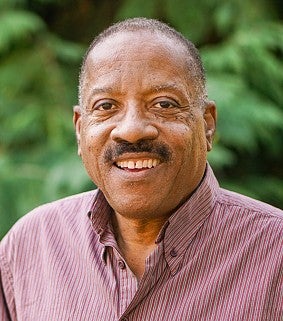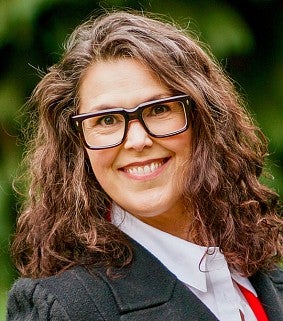
Whether it’s voice assistance, spelling and grammar check, Google Maps or ChatGPT, we’re all already using artificial intelligence (AI). UO School of Journalism and Communication (SOJC) faculty recognize it’s more important than ever to get a head start in understanding emerging technologies, like AI, that will become part of our everyday lives. Here’s how four of our faculty experts are leading the way to the future of AI in journalism and communication.
Researching the future of AI in journalism
Seth Lewis, SOJC professor, and Shirley Papé, Chair in Emerging Media, director of the undergraduate journalism program
For the past decade, Seth Lewis, professor and director of journalism at the SOJC, has been studying automation, algorithms and emerging forms of AI. With his research partners, Lewis focuses on the integration of AI in the newsroom, including its effects on how news is made, how journalists do their work and how news reaches people across platforms.
“What has changed in recent years is the introduction of machines that are intended to take on tasks that we normally associate with humans. That’s the essence of AI,” Lewis said. “It forces us to ask challenging questions: What does it mean to delegate roles and responsibilities that we have traditionally associated with being human, and offload those to machines and allow algorithms and software systems to make those decisions for us?”
His team has published research in two main areas: human-machine communication and what AI should do for journalism. To explore human-machine communication, Lewis contributed to the Sage Handbook of Human-Machine Communication and co-authored a research article in the research journal New Media & Society that explored, for the first time, “communicative AI” and the functional, social and existential issues that arise when AI is used for communication.
In the article “The One Thing Journalistic AI Just Might Do for Democracy,” Lewis and SOJC Communication and Media Studies Ph.D. student Bibo Lin explain how AI should work in the service of news accuracy, accessibility, timeliness, relevance and diversity.
Lewis and his team are also examining how journalists talk about ChatGPT in news coverage compared to trade press coverage. In news coverage written for the public, the press tends to paint a more dramatic picture of generative AI’s potential to replace human labor, Lewis said. But in the trade press, where journalists are writing for one another, writers were more apt to acknowledge the value of AI for journalists.
“There's a tension there,” Lewis said. “I want to continue to study this tension between how journalists and other information professionals see AI as threatening on one hand, but they also see it as potentially liberating on the other. They see it as something that might make their job obsolete in a worst-case scenario, but they also see it as something that could help them do their job faster and better. In between those two things or in some combination of them is going to be the reality worth exploring.”
One aspect of generative AI that Lewis and his team are trying to untangle is what different types of AI mean for different types of journalism.
“A lot of attention is being paid to ChatGPT right now, and for good reason,” he said. “But that's only one model. It's only one flavor, and different models and flavors could end up actually having a bigger impact. We know people are creating custom ChatGPTs. You can take an existing AI model and then feed it your own work to build a more powerful assistant — almost like an intern for everyone.”
Lewis offers an example: “As a professor, if I wrote a 500-page textbook, within a few hours I could build a chatbot based on that book that would allow students to have something of a conversation with me about the book’s contents. That has a lot of potential in education, but it also has potential for ways that journalists think about creating a kind of ‘digital twin’ with whom they can correspond and help them accomplish tasks in new and emergent ways.”
Murrow.AI: A custom chatbot for journalistic writing
Ed Madison, SOJC associate professor, executive director of the Journalistic Learning Initiative

With over 8,500 users since its release in November, Murrow.AI (named for legendary journalist Edward R. Murrow) has quickly become a go-to resource for emerging journalists. Co-founded by Ed Madison, an SOJC associate professor, Murrow is the first generative AI chatbot oriented around journalistic writing. As the executive director of the Journalistic Learning Initiative (JLI) — an Oregon nonprofit dedicated to improving learning outcomes for K-12 students nationwide — Madison collaborated with Playlab.ai to create this first-of-its-kind tool.
“We developed Murrow as a tool to help educators who are looking to use and promote the use of AI responsibly. There's a lot of fear and concern about cheating and students having shortcuts to learning. So we wanted to develop a tool that would really inspire thinking,” Madison said. “[Murrow] doesn't really give you answers. It coaxes you to ask better questions and formulate answers for yourself.”
As a tutor for journalistic writing, Murrow.AI can help writers get started and offer title ideas, editing suggestions or potential interview questions.
“Several professors in the School of Journalism have reported to me that they're using it with a great degree of success in their reporting classes and with their publications,” Madison said. “I know of several instances where it's being used rather prevalently in SOJC classes.”
When asked if AI will replace jobs, Madison said, “The answer is no. What it does is free up time. It answers some of the pedestrian questions and concerns that typically come up that teachers and editors have to repeat over and over again … and frees up teachers and editors to spend more quality time with their students.”
Madison acknowledged that AI is not going away, so we are faced with a choice: “We either embrace it and figure out ways to use it responsibly, or we run in fear and get left behind.”
Using AI in public relations and strategic communication
Donna Davis, SOJC associate professor, director of Immersive Media Communication Master’s program, co-director of the Oregon Reality (OR) Lab

As a teacher of a class on using AI for communication and a researcher who studies the use of AI in communication, Donna Davis is familiar with testing and playing with emerging technologies.
From her interviews with public relations professionals around the world about their use of AI, Davis and a team of colleagues found that professionals see AI as a game changer in productivity. But they also think it creates new challenges, including the changing nature of billable hours and more demanding expectations for both clients and bosses.
“An agency person said, ‘We're not worried about AI taking your job,’” Davis said. “’It's the person that knows how to use AI that's going to take your job.’ The person who's really embraced it, harnessed it and figured out how to optimize AI is going to be the sought-after employee in our world in the future.”
AI use is becoming increasingly prevalent in the public relations field for composing press releases and speeches and turning short speeches into PowerPoint presentations. Davis referred to a study that found 67 percent of public relations professionals are using AI to create content.
Recently, Davis was a co-presenter for a national webinar with the founder of Delphi, an agency that builds virtual clones.
“It only takes a matter of seconds to clone your voice, your facial expressions, and boom: There is the perfect clone of you,” she said. “We've already seen influencers making tons of money by the minute, charging by the minute to talk to their clone, not even to them.”
In the future, Davis believes AI will be even more embedded in our day-to-day life. She also thinks it has the potential to create more inclusive workspaces.
“If you've got somebody with a learning disability, AI can take what might be in their mind and interpret and produce it in a professional way, where traditionally, if you are challenged by something as basic as spelling or grammar, people don't trust your work. There are some brilliant people out there who just really can't spell or they're dyslexic, and AI can tidy that up,” Davis said. “Spellcheck and Grammarly have been my best friends for the last several years. But even with those tools, there still has to be that human follow-up to check for accuracy.”
Davis emphasizes just how important that human follow-up is: “It's really important that we're teaching our students how to responsibly, ethically, effectively and efficiently use AI. And it's really important that students understand their responsibility as editor, proofreader, fact checker, because AI is known to make errors, or even ‘hallucinate’ — the term used when AI fills in gaps based on what it thinks is a likely answer. When I asked an AI tool, 'Who is Donna Z. Davis, Ph.D.?’ the third paragraph started by stating that I had died in 2017. Imagine the challenge that can create if those types of fact errors aren't checked and corrected before going public.”
AI for the win, now and in the future
Lisa Peyton, SOJC immersive and strategic ccommunication instructor

With a background in working on Intel’s AI strategy and teaching AI, immersive and strategic communication instructor Lisa Peyton has practical experience exploring the technology’s innovative uses for marketing, advertising and public relations. Peyton uses some form of AI for all of her consulting clients and includes information about AI in all of her courses.
According to Peyton, strategic communication professionals use AI to help with analytics and social listening, and they use generative AI to create content, research target audiences, brainstorm compelling topics and create outlines.
“From helping to tweak copy to creating thumb-stopping visuals, all agencies I work with are using AI in some fashion,” she said. “Most agencies have embraced generative AI tools like Midjourney, Runway.ml and DALL-E to help create and scale content.”
In her SOJC writing courses, Peyton shares three rules to ensure students are using tools like ChatGPT to be more productive and creative: “One, be transparent and always share when you have used AI. Two, don't let AI be your only source of truth, and always fact check. And three, don't enter any sensitive information into an AI tool,” she said.
In her XR for PR (J-480) topics course, Peyton dedicates a few weeks to exploring AI. She covers how AI is used across the planning, promotion, production and performance phases of PR campaigns. Her students also explore how generative AI is exponentially speeding up the creation of 3D content and immersive experiences, giving almost anyone the ability to create engaging content.
“As these tools are rapidly evolving, we all need to rapidly evolve our own education, understanding and skills to ensure we don't get left behind,” she said. “AI will become an essential tool at work in every profession, and those who ignore it or aren't open to learning how to use it will become irrelevant. Agencies, brands and communications professionals who understand large-language models, how to craft an effective prompt and are along for this crazy AI ride will be the winners of the future.”
—By Sydney Seymour, class of ’25
Sydney Seymour '25 (she/her/hers) is a media studies major minoring in ethics. She is a writing intern for the SOJC and the executive writing editor for Align magazine. Connect with her on LinkedIn.
